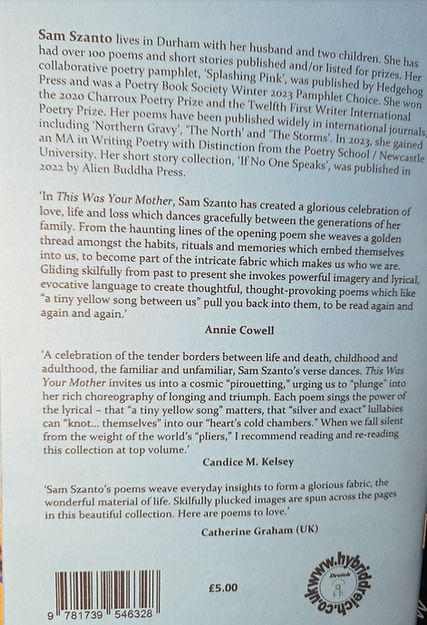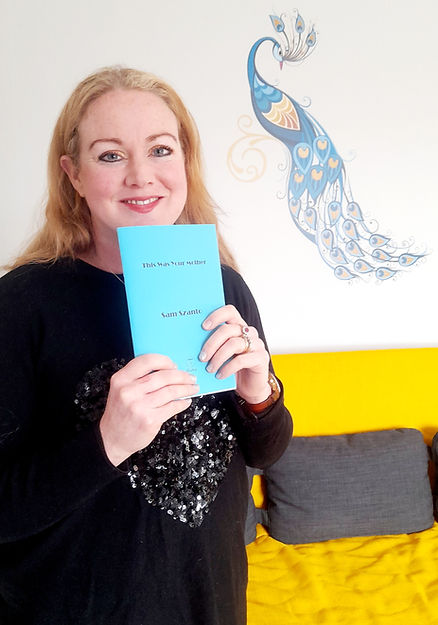Karen Pierce Gonzalez: 'What was most important was what was left behind'
- samszanto2
- Mar 23, 2024
- 7 min read

A chat with Karen Pierce Gonzalez about her chapbook, ‘Coyote in the Basket of my Ribs’ (Kelsay Books, 2023)
What a title! How did you come up with it? Were there any others in the running?
Initially I worried this title would be too long. But, honestly, I stayed with it because the collection is about holding the Coyote so close to me (in my ribs) as it was holding me.
And what a cover pic! Who created it?
Credit goes to Shay Culligan.
How would you describe the chapbook in one sentence?
A Coyote-guided journey through the landscape of loss.
Could you talk to me about what coyotes mean to you?
Coyote is a spirit that roams freely between life and death. Familiar with survival, this ally does not lose itself in the details, but rather makes a place for itself wherever it is in the process of grief.
Grief and loss – and longing – are very present in so many of the poems in the collection. I made the assumption that poems such as ‘A Photo Marked Only Kids, 1963’ (which is so poignant, powerful and emotive) are at least partly autobiographical and wonder how it feels to have the poems ‘out there’ with others making the same assumption? I’ve written on a similar theme and with their publication can feel both catharsis but also of appearing as naked – not necessarily ‘judged’, more ‘seen’, with all this brings. I don’t know if this is similar for you?
Yes, your senses are correct. This is autobiographical and yet, my personal experiences have their roots in the shared common ground of losing a loved one. What I find breathtaking is how what was most important was what was left behind, so to speak. The love for my young sister continues to this day even though we no longer share the same physical world. So, in that, this book is a celebration of love and, as in many of my works, it is more of a tribute to the spirits who provide assistance than it is a elegy of loss.

In ‘Ferryman of Hades, you write: ‘Nothing, the ferryman says, / not even death, is free.’ I found this a very intriguing concept and wonder if you could talk about it? And perhaps also about the interrelationship between myth and grief in poetry?
The Ferryman is capable of caring for the dead, the living and the near dead, as my mother became when my sister died. (They had driven to the store for me and had a car accident).
I believe that mythic beings, like this figure, are capable of taking on suprahuman responsibilities. In this case, he was kind to my mother whose loss of one daughter and abandonment of another was the fee she had paid. I found comfort in his presence in the collection for he was able to care for her in a way I could not. And yet, he still kept watch over me.
How is the book (or the poems in general) different or similar to what you’ve written before?
This was my first published chapbook and the first time I constructed work around dreams in which I could interact directly with Coyote spirit.
Do you write between genres?
All the time! I find the versatility allows me to move from one form to another, dependent upon the needs of the content. A flat short story can come alive as a script, etc.
What I have found to be most important in fiction, poetry, non-fiction, is the ability to let the story line move as needed to retain its beauty.
I apply the same approach to my art. Creative energy moves in many directions, so the broader the playing field, so to speak, the better. Makes ‘getting stuck’ almost impossible.
How long did the book take to write?
I have been living with it on and off for decades as an internal experience. The process of bringing it together in this form was probably about four months.
Keep in mind, I was also working on other writings, as well as art-related projects. And this is my strategy: to keep the flow flowing, I will focus upon a different piece of work when I feel stymied or when I am aware that I am forcing something to blossom prematurely (which is the surest way I know to stifle it!).
Karen Pierce Gonzalez’s ‘Coyote In the Basket of My Ribs’ is an exquisite exploration of restlessness. She expertly transcribes the sadness of the untamable that cuts its “teeth on the raw edges of my heart” and a deep connection with wildness that in “darkness dissolves the certainty of my calm about which shadows are tame enough to clothe and feed”. Her coyote dream poems are intertwined with a delicate, involving understanding of loss, of dependency on the just-out-of-reach, and the melding of domesticity and other.
Marcelle Newbold, poet, 38 Managing Editor, Nightingale & Sparrow
What is your writing routine?
It varies, dependent upon what the project is.
I start everyday with meditation, a reading from Tao Te Ching and usually body movement (yin yoga, qi gong, etc.) This routine gives me a greater awareness of how my day needs to go, what my own energy flow needs. Sometimes this means rewrite in the morning, art mid-afternoon, or generating the start of something new after evening family time and before bed.
Any tips for poets wanting to publish a collection?
Yes. Learn your own rhythms and how you can best serve your own creativity. As a writing workshop facilitator, I always told participants they could NOT edit or critique a piece of work that had not been written. So, first things, first.
In this way, we pay homage to the inspirations that bubble up from our creative wellsprings regardless of when/if or where they appear in the world.
Come to know your own strengths and weaknesses. For example, I rarely submit any work to competitions or contests because they portend a ‘win/lose’ strategy. Not a positive place for me.
This book, and several others, were all submitted to publishers open to receiving manuscripts that were not competing with one another. How can an orange and an apple make the same dessert?
How did you sequence the poems / select what went in or out?
Most of the poems were written independently of one another. This wasn’t planned; this was their flow. It worked well because they were authentic and did not have to fit a particular slot. Once they were done, I played with the order paying special attention to the rhythm of the overall book, always looking for the strongest, truest beat. There were a few gaps and in them I wrote poems to build bridges.
In hindsight, I would’ve placed a few in different places, but don’t worry about that because the point of Coyote in the Basket of My Ribs is to follow Coyote who moves, sometimes unexpectedly, in and out of locations.
Karen Pierce Gonzalez has managed an opus of quiet trilogy in her latest release, Coyote In the Basket of My Ribs. Channeling the spirit of a sister coyote; a sister lost, and back against the brittle wall of family - Pierce Gonzalez takes us ever so gently, lovingly, along a midnight, bright dawn gulch of harrow and soothe. At times we feel the “barbed angles in this house”, at times “a silhouette on a jagged outcrop”, even stil , and even so: “coyote dodges the headlights of dawn”, as does our author in this tightly-enchanting-intimate collection. The question I leave with, but already sense the answer to: whose ribs cradle whose… and can they exist without the other?
Elisabeth Horan, MA, MFA
Editor in Chief, Animal Heart Press
I admired the varying use of form throughout the collection, and wondered if you could talk a bit about formal choice, and how you decide what form to use for a particular poem?
Again, because I had the luxury of writing these pieces as standalone poems, their forms reflected what I wanted to say and how I wanted to say it. This makes the composition of the whole easier than one would think.
Why did you decide to use Roman numerals for the Coyote Dreams poems?
Roman numerals have a gravitas, a formality to them that anchors the more-elusive dream world. I wanted the staid and true, rather than the contemporary system of chronicling the order.
How have people reacted to the book? There are some deservedly great reviews on Amazon… I wondered if you have a favourite reaction? Or if anyone has reacted in a way that has surprised you, maybe by seeing things in the poems you hadn’t seen yourself?
I have had the good fortune to receive favorable feedback. Each review reflects what the reviewer found important. I love diversity like that. It tells me the personal in this book has universal resonance.
My most poignant feedback came from Matthew MC Smith, Publisher, Black Bough Poetry Press who noted to me that he read the book three times consecutively and cried anew every time. Those were his tears about his loss as much as they were about mine. And that told me that I did not need to hammer people over the head with details about my grief. Rather, I was able to share precious moments of longing that tell their own stories.
In her newest chapbook, Karen Pierce Gonzalez wanders the liminal spaces between self, existence, and dream. Woven throughout Coyote In the Basket of My Ribs is the urge to protect the sacred wilderness that haunts within, all the while attempting to navigate the intangible aches of grief and memory. Set in the gorgeous landscapes of ‘cotton duvets’, ‘sky maps’, and ‘southwestern mesas’, this collection is a gentle dreamdappled journey that examines the fragile balance between a longing to hold and a longing to let go.
Jenny Wong, author of “Mouthed” (Kissing Dynamite Press) and the short poem film series, “Compostable Morsels”.
Do you have a particular poet (or a few) who inspires your own work?
I am inspired by so many writers. Poet Ankh Spice (Water Engine, Femme Salve Books) is among my favourites. Barry Lopez is at the top of my non-fiction list (Winter Count, Vintage). And for fiction? None other than Alice Hoffman whose novels of magic realism (The Dove Keepers, Practical Magic, The Museum of Extraordinary Things are only three of her many works) bring to life multi-dimensional worlds so beautifully crafted they keep my engaged (and drooling) for hours at a time.
What are you working on now?
I have just completed a new hybrid collection (art/poetry/prose) and am creating hybrid videos of poetry/art as well as creating original prequels and sequels to folktales (i.e., discovering Rapunzel’s cut hair long, long after the story has ended).










Comments